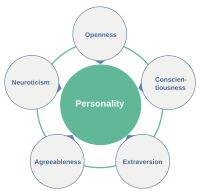
Photo from wikipedia
We examined multiple dimensions of religiosity and their relationship to the four DSM-5 PTSD symptom clusters among US Veterans and Active Duty Military (ADM), hypothesizing that religiosity would be most… Click to show full abstract
We examined multiple dimensions of religiosity and their relationship to the four DSM-5 PTSD symptom clusters among US Veterans and Active Duty Military (ADM), hypothesizing that religiosity would be most strongly inversely related to negative cognitions/emotions (Criterion D symptoms) and less strongly to neurobiologically based symptom clusters (B, C, and E). This cross-sectional multisite study involved 591 Veterans and ADM from across the southern USA. Inclusion criteria were having served in a combat theater and the presence of PTSD symptoms. Measures of religious beliefs/practices, social involvement, and PTSD symptoms were administered, and bivariate and multivariate analyses were conducted in the overall sample, and in exploratory analyses, in the sample stratified by race (White, Black, and Hispanic). In the overall sample, multivariate analyses revealed that the only PTSD symptom cluster inversely related to religiosity was Criterion D, and only to organizational (b = − 0.08, P = 0.028) and cognitive/intrinsic religiosity (b = − 0.06, P = 0.049), relationships that were fully explained by social factors. Religious struggles, in contrast, were positively related to all four symptom clusters. Inverse relationships with Criterion D symptoms were particularly strong in Blacks, in whom inverse relationships were also present with Criterion E symptoms. In contrast, only positive relationships with PTSD symptom clusters were found in Hispanics, and no relationships (except for religious struggles) were present in Whites. As hypothesized, the inverse relationship between religious involvement and PTSD symptoms in Veterans and ADM was strongest (though modest) for Criterion D negative cognitions/emotions, especially in Blacks.
Journal Title: Journal of Religion and Health
Year Published: 2019
Link to full text (if available)
Share on Social Media: Sign Up to like & get
recommendations!